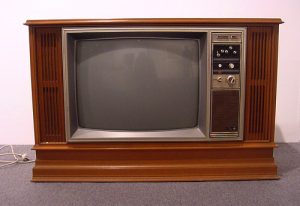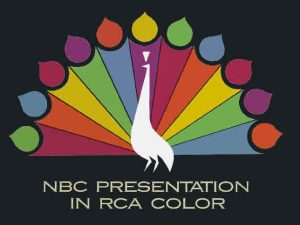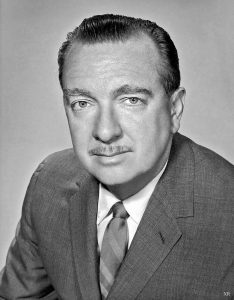13 Television
By Dave Bostwick
When I was an annoying kid in the early 1970s, we had one TV set in our house and three choices for watching television each evening – whatever was broadcast on ABC, CBS or NBC.
 The Sunday morning newspaper included a weekly TV schedule. Under my mother’s supervision, my sister and I would use different colored pens to circle the shows we wanted to watch that week, thus reserving our TV time in advance. I always circled The Brady Bunch.
The Sunday morning newspaper included a weekly TV schedule. Under my mother’s supervision, my sister and I would use different colored pens to circle the shows we wanted to watch that week, thus reserving our TV time in advance. I always circled The Brady Bunch.
A decade later, I was fascinated that a cable network that only showed music videos (MTV) or sports (ESPN) could become popular so quickly. Their specialization broke the mold of television’s broad appeal and family focus.
As you study this chapter, you’ll understand that television’s history in some ways repeats the history of radio. Both enjoyed broad nationwide appeal as the medium of choice, but disruptive technology and economic models caused them to evolve toward specialization. For radio, the disruptive technology was television.
For network television, the first disruptive technologies were satellite and cable transmission, which led to more channels and more choices. Next came the internet’s impact on the nationwide television industry, which led to an increasing variety of screens, some portable, for consumers to view video content.
YOUR MEDIA LANDSCAPE
Seeing is believing OR reading is believing?
Generally speaking, do you have greater trust in content that you see and hear through video and television, or do you place more trust in what you read? How does the evolution of AI-generated video affect your response?
INVENTION
A teenager from Idaho is often credited with inventing television, although there were other contributors along with the way. Below is a History Channel documentary about Philo Farnsworth and his early experiments with television. This video is also an example of a documentary that relies partly on staged re-enactments. Consider how that affects your impression of the video.
TELEVISION NOTES AND TIDBITS
American television began to dominate the mass media landscape in the 1950s. According to one historical summary, “The number of television sets in use rose from 6,000 in 1946 to some 12 million by 1951. No new invention entered American homes faster than black and white television sets; by 1955 half of all U.S. homes had one.” And by the late 1990s, 98 percent of U.S. homes had a television set.
For additional perspective, here are a few bullet points, in chronological order, about the evolution of television between the 1930s and the 1970s.
- In the 1930s, television had small screens, typically no larger than 12 inches.
- Early black-and-white TV sets ranged from $200 to $600 in cost, while the average annual salary was $1,368. Only the rich could afford one. As a comparison, if someone today makes $50,000 per year, they probably would not spend $15,000 on a television set.
-

Creative Commons Image NBC was the first national network with regular television broadcasts, including 1939 during the World’s Fair in New York. The first three major networks – NBC, CBS and ABC – began as radio networks and transitioned to television. (Fox’s television network did not launch until 1986.)
- In the 1940s, the Federal Communications Commission set technical standards so that content from all networks could be viewed on the same television. Otherwise, people might have needed one TV for NBC and another for CBS, for example.
- In 1954, the first national color broadcast came via the Tournament of Roses Parade on NBC. Although experimentation with color television was part of the 1950s, the Big Three networks (CBS, NBC and ABC) did not broadcast all of their evening shows in color until 1966.
- By 1972, color TV sets outnumbered black-and-white TV sets in the United States.
 Thanks to satellite transmission and cable, Home Box Office (HBO) launched in 1972 and, by offering premium content, has become the longest-running subscription television service. WTBS became the first cable superstation in 1976, and television’s revenue model gradually shifted to include cable subscription fees instead of relying solely on advertising on the Big Three networks.
Thanks to satellite transmission and cable, Home Box Office (HBO) launched in 1972 and, by offering premium content, has become the longest-running subscription television service. WTBS became the first cable superstation in 1976, and television’s revenue model gradually shifted to include cable subscription fees instead of relying solely on advertising on the Big Three networks.
FROM RADIO TO TV
Many early programs were merely TV-versions of content that began on radio, including soap operas and variety shows. For example, Jack Benny began hosting radio shows in 1932 and made the transition to television in 1950. Below is the debut episode of The Jack Benny Show on television. The video below shows an embedded advertisement for cigarette-maker Lucky Strikes, the show’s sponsor, and then a musical sketch so you can gain a sense of early television production.
SURVIVING SHOWS
A few remnants from the pioneering days of network television survive today. Meet the Press first aired in 1947, Today in 1952, andThe Tonight Show in 1954.
You may enjoy watching the start of this archived weather forecast from the first broadcast of the Today show.
THE SIGNIFICANCE OF I LOVE LUCY
In 1951, I Love Lucy became the first television program filmed before a live studio audience. A PBS feature story listed other ways I Love Lucy transformed television, such as casting a Hispanic co-star, setting the standard for filming a comedy show with three cameras, and incorporating Lucy’s pregnancy prominently in some episodes.
In the excerpt below, other characters prepare to take a pregnant Lucy to the hospital.
And notice the switching of camera angles in the the next excerpt, set in a chocolate factory.
QUIZ SHOW SCANDALS
Many early shows were created, produced and sponsored by a single company, but longer, segmented programs such asToday and The Tonight Show started forcing advertisers out of producing their own content.
This change was also related to the quiz show scandals of the 1950s. One prominent case involved Geritol’s Twenty-One. A contestant who won more than $100,000 later admitted that he had been given answers in advance. Here’s a video that summarizes the case.
Because of rigged quiz shows, television lost credibility. Americans could no longer consider television more honest than printed text. A little over a decade later, this lack of trust likely caused some Americans to believe that TV producers had colluded with the government to stage footage of U.S. astronauts walking on the moon.
On the other hand, as we see repeated throughout media history, audiences sometimes crave entertainment at the expense of truth. A PBS analysis of the quiz show scandals summarized the perspective of Manhattan Assistant District Attorney Joseph Stone:
The true victims were not the contestants, Stone writes, many of whom made money, but the television viewers hoodwinked into believing that the fiction they were watching was actually real-life drama. But even television viewers seemed not to mind.
IMPACT OF TELEVISION ON RADIO AND NEWSPAPERS
TV’s immense popularity impacted other media. For example, before television, radio stations and radio networks could afford to produce lots of original shows for large audiences. As advertisers and audiences left radio for television, radio began to rely heavily on recorded music for programming because that was a more cost-effective strategy.
 As another example, when evening news broadcasts gained popularity, large-city newspapers began concentrating on morning rather than afternoon delivery of their print product. The afternoon newspaper could not compete with the immediacy of television news. Also, the onset of color television hastened the need for newspaper publishers to print in color, even though it was more costly.
As another example, when evening news broadcasts gained popularity, large-city newspapers began concentrating on morning rather than afternoon delivery of their print product. The afternoon newspaper could not compete with the immediacy of television news. Also, the onset of color television hastened the need for newspaper publishers to print in color, even though it was more costly.
Evening news shows on the major networks became an integral part of many Americans’ daily lives. Prominent news anchors such as Walter Cronkite (pictured at right) became extremely influential. In the 1960s, Cronkite was sometimes called “the most trusted man in America.” He was also known for his closing catchline at the end of each newscast: “And that’s the way it is.”
THE DECLINE OF THE MAJOR NETWORKS
Networks often pay a fee to affiliate stations to carry network programs. In return, networks sell advertising time. Networks usually do not own their affiliates.
 The three major networks — ABC, CBS and NBC — thrived through the ’60s and ’70s, accounting for 95 percent of prime-time viewing. When News Corporation launched Fox in 1986, its entertainment targeted younger viewers. Fox also recognized the importance of sports, specifically the NFL, in establishing its brand.
The three major networks — ABC, CBS and NBC — thrived through the ’60s and ’70s, accounting for 95 percent of prime-time viewing. When News Corporation launched Fox in 1986, its entertainment targeted younger viewers. Fox also recognized the importance of sports, specifically the NFL, in establishing its brand.
By 2005, the percentage of prime-time viewers for the four major networks had dropped below 45 percent. This decline was caused partly by communications satellites facilitating cable television along with Americans enjoying home video options — first VHS, then DVR and internet streaming.
In 1977, only 14 percent of all U.S. homes received cable. By the summer of 1997, a landmark shift had occurred as basic cable channels had captured a larger prime-time audience than the broadcast networks.
CNN – the Cable News Network — began in 1980 and gained credibility in 1991 with coverage of the Gulf War. Even Iraq’s leaders watched CNN’s continuous live coverage (something the major networks could not provide).
Also, as cable news networks (first, CNN, and later MSNBC and Fox News) became more popular, the legacy networks (NBC, CBS and ABC) concentrated more on newsmagazines such as Dateline and 20/20 in an attempt to replicate the success of CBS’s 60 Minutes.
THE RISE AND FALL OF CABLE TELEVISION

As viewership for the major networks declined, cable networks that focused on specialized entertainment content began to rule the television landscape. Examples include MTV, the Cooking Channel, HGTV, CMT, BET, VH1, TNT, Comedy Central, Lifetime, Nickelodeon, and the USA Network.
In an article from the Associated Press, Eric Degas, an NPR television critic, discussed the popularity of specialized cable television from the ’80s to the early 2000s:
People who were previously marginalized by the focus on mass culture suddenly got a voice and a connection with other people like them. So young music fans worldwide bonded over MTV, Black people and folks who love Black culture bonded over BET, middle-aged women bonded over Lifetime and fans of home remodeling convened around HGTV and old-school TLC.
Cable television viewership peaked in the early 2000s but then began a slow decline due to competition from internet streaming services such as Netflix and Hulu. Today, some of these once-powerful cable network brands can be described as TV’s ghosts — networks that somehow survive with little reason to watch them anymore.
For example, many younger viewers today are not even aware that MTV stands for Music Television Television or that in its heyday, MTV exclusively played new music videos and did not air reality-TV shows.
OTHER SIGNIFICANT EVENTS
These three time stamps are worth mentioning.
- The Telecommunications Act of 1996 allowed regional phone companies, long-distance carriers, internet service providers and cable television companies to enter each other’s markets. Today, for example, your internet provider, phone provider and cable television provider can be the same company. This led to massive industry consolidation.
- The switch from analog to digital became complete in 2009 with all stations broadcasting digital signals. Television sets no longer receive analog signals via antenna. The FCC has reclaimed and auctioned unused analog frequencies.
 The debut of Hulu Plus in 2010 allowed viewers to stream favorite shows to a variety of devices, opening up a new market area and redefining the concept of television. Today, the distinction between the computer screen and the television screen is melding, partly because of the emergence of streaming services such as Hulu and Netflix.
The debut of Hulu Plus in 2010 allowed viewers to stream favorite shows to a variety of devices, opening up a new market area and redefining the concept of television. Today, the distinction between the computer screen and the television screen is melding, partly because of the emergence of streaming services such as Hulu and Netflix.
On the other hand, many streaming services now offer ad-free streaming for a premium price and ad-supported versions for those who prefer to save their money. The Atlantic’s Lora Kelley made this observation:
One by one, most of the major streaming services have introduced ads to their subscription offerings. Now consumers face a choice: Pay up, or sit through commercial breaks like it’s 1999.
 The free video platform Tubi gained increasing attention in 2024 as a popular alternative to paid streaming services. Tubi’s revenue comes exclusively from advertising and it does not require users to create an account to view content. A New York Times analysis said, “Tubi’s library contains tens of thousands of older shows and movies, many that seem to have been collected from the bargain bin,” which suggests that many U.S. viewers love the idea of free content (with ads). Tubi is owned by the Fox Corporation.
The free video platform Tubi gained increasing attention in 2024 as a popular alternative to paid streaming services. Tubi’s revenue comes exclusively from advertising and it does not require users to create an account to view content. A New York Times analysis said, “Tubi’s library contains tens of thousands of older shows and movies, many that seem to have been collected from the bargain bin,” which suggests that many U.S. viewers love the idea of free content (with ads). Tubi is owned by the Fox Corporation.
FOOTBALL AND MORE FOOTBALL
As television has become specialized and viewers have more on-demand streaming options beyond large-network shows, there are fewer moments when many millions of Americans are watching the same thing at the same time — with one notable exception.
A Wall Street Journal analysis observed that for television networks, “sports content is outrageously expensive but also critical to own in an industry in which it is one of the few reliable ways to draw in audiences.”
In 2024, the 11 most-watched prime-time television shows and events in the United States were NFL games. A presidential debate ranked 12th followed by the Oscar Awards and two more NFL games to round out the top 15. Overall, Variety reported that 75 of the top 100 slots involved sports programming.
Let’s briefly go to the wayback machine to catch a glimpse (no sound in this clip) of the first televised NFL game.
WRAPUP
Television has had a profound social and cultural impact on Americans. Traditionally, television has given us “common ground,” and until the last 25 years it had not been as specialized as other media. There have been historic moments when the majority Americans watched in unison. Here are some examples through time:
- immediate coverage of the Kennedy assassination
- the final episode of M*A*S*H*
- O.J. Simpson chase
- immediate coverage of 9/11
- the beginning of the Iraq wars
- Hurricane Katrina
- Super Bowls
- presidential election coverage
- Jan. 6, 2021
Today’s on-demand streaming options have radically changed consumers’ viewing habits. Many Americans have been labeled “cord cutters” because they use only wireless devices to access streaming video content, which has threatened the future of traditional cable and network television. Streaming viewership reached a historic television milestone in 2025 when, according to a Nielsen report, total streaming usage on televisions usage overtook the combined share of broadcast and cable content.
And I’ll close with some geezer perspective to echo the chapter introduction. I was once a kid with a choice of watching ABC, CBS or NBC during prime time (7 to 10 p.m., central time) on a box-shaped television with a rotary dial. I couldn’t have imagined a television landscape with hundreds of on-demand options and networks based entirely on shows about home and garden (HGTV), cooking (Food Network), or vacations (Travel Channel).
And I certainly couldn’t have imagined that 50 years later I’d be able to watch rerun episodes of The Brady Bunch on a portable phone screen, with no connecting cord involved.
Television has evolved rapidly.
TRUE or FALSE
The following questions highlight a few tidbits of information from the chapter. Use the forward button to advance through the questions.
DRAG-AND-DROP: TELEVISION HISTORY (last half of 20th century)
TRUST IN VIDEO & TELEVISION – ASSIGNMENT
Let’s revisit one of the chapter’s opening questions:
Generally speaking, do you have greater trust in content that you see and hear through video and television, or do you place more trust in what you read?
Related to the embedded chapter video about quiz show scandals during the ’50s, you may also want to discuss the extent to which you are concerned about the authenticity of modern game shows and reality TV series. (For example, in the ’50s, some viewers didn’t seem overly concerned when they later learned that a quiz show had been rigged.)
You could also discuss whether AI-generated content, especially video, has changed your attitude.
Be specific about your own viewing and reading habits, especially for informational content. Also, include pieces of support from the chapter.
Write at least 250 words in journalistic style with approximately three sentences per paragraph.
ADDITIONAL SOURCES
- The Evolution of Television – Understanding Media and Culture
- The Relationship Between Television and Culture – Understanding Media and Culture
- Media & Culture — by Richard Campbell, Christopher R. Martin, and Bettina Fabos

